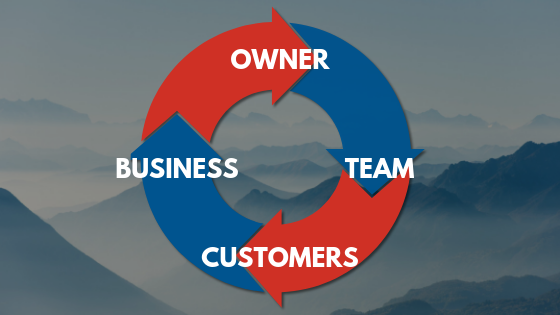Many business owners find themselves in the trap of trying to do too much and not allowing their employees (team) to help them. This is probably the single biggest inhibitor to growth that I have witnessed over the last eight years of coaching businesses – the failure of the owner to get out of the way, and to empower their team. Too many owners feel that it is their responsibility to personally take care of everything, because “I can do it better” than anyone else. All that this approach provides is the guarantee that you will be the busiest and least paid (on a per-hour basis) employee in your business, the only one who comes in early and stays late. If you enjoy being a slave to your business and your customers, stop here. If you need to get past that, read on.
The problem is that most business owners believe that they are responsible for taking care of their team, their customers, and their business all on their own, and not necessarily in that order either. In reality, the Owner/Leader’s #1 Customer is their Team.
The most effective way to grow your business profitably is to adopt the following Cycle of Business model: Owner > Team > Customer > Business > Owner. In plain English, this can be read as the owner takes care of the team, enabling the team to take care of the customers, which leads the customers to take care of the business with repeat orders and referrals, which results in the business rewarding the owner with profits and success. Let’s look at what goes into each of these four steps.
As the owner, your primary responsibility is to your team. You need to hire the best people, provide them with the tools to perform their work, and train them how to properly use the tools to service your customers. The types of tools you should provide include: Vision and Mission, Company Culture, Core Values, Goals, Job Descriptions, Processes and Procedures, Communication Channels, and Services and Products that your target markets want. In addition to tools, your team also needs you to be their leader and cheerleader, and recognize their needs and successes.
Armed with the proper tools, your team can now take care of your customers. This means providing them with high quality, consistent, responsive service and delivering your products and services with a smile, every single time. Winning teams exhibit leadership qualities, share common goals, know who is responsible for doing what, support and include each other. Successful teams listen to customers’ problems and identify solutions before they are asked.
When customers are treated well, receive prompt courteous service, and consistent high quality products that solve their problems, they come back again and again, and they tell their friends. When your team solves customers’ problems, your customers reward you with loyalty. Loyal customers can then be involved in helping you to grow your business successfully by giving you critical feedback on how you can help them even more, and opportunities for new business that you might never have had otherwise. When your customers are well cared for, they take care of you and your business so that you can remain in business to help them.
So take a step back and make sure you are performing your number one job – taking care of your team. Help the team take care of your customers, and let your customers grow your business. Repeat.
Author: Mark McNulty, Business Coach in Louisville, KY
[/et_pb_text][/et_pb_column][/et_pb_row][/et_pb_section]
